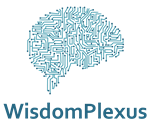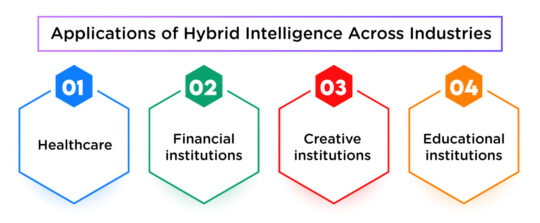Human intuition and computing capability have a deep junction in the vast fabric of human innovation. It is a partnership that surpasses the constraints of each component operating alone. This combination, referred to as hybrid intelligence, is a fundamental rethinking of how complicated issues might be solved using complementary cognitive talents rather than just a technological advancement.
Between 2023 and 2032, the hybrid intelligence market share is expected to progress at a compound annual growth rate (CAGR) of 25.6%. The greatest innovations of our day come from the conscious cooperation of humans and machines rather than from either functioning alone or without assistance.
Problem-solving techniques that are more resilient, advanced, and successful than either element could be on its own when human creativity, moral reasoning, and contextual awareness come together with computational pattern recognition, data processing skills, and unending analytical power.
What Is Hybrid Intelligence?
The synergistic cooperation of computing systems and human cognitive capacities is known as hybrid intelligence. In order to address difficult issues more successfully than each could on their own, this collaboration combines the complementary assets of both organizations—human intuition, creativity, and contextual awareness with machine processing capacity, pattern recognition, and data analytic capabilities.
In collaborative decision-making frameworks implemented by these architectures, computational systems manage data processing, statistical analysis, and optimization tasks, while human experts offer high-level reasoning, moral judgments, and innovative ideas. This produces a dynamic feedback loop. Here, human decision-making is informed by system-generated insights, and system outputs are shaped by human guidance.
AI and Human Synergy: Enhancing Decision-Making and Creativity
AI and human collaboration are demonstrated through interactive interfaces in which computational components quickly process data, analyze statistics, and identify patterns while human domain experts offer heuristic expertise and innovative insights. Both proactive and reactive methods of problem-solving are made possible.
It is done by the resulting hybrid intelligence ecosystem, especially in settings with ambiguous or insufficient information. Implementation architectures usually include feedback mechanisms that support ongoing learning, in which human decision-making is informed by machine-generated insights and computational outputs are refined by human supervision.
These complementing skills are particularly useful in fields like medical diagnostics, financial forecasting, and creative design processes. These fields call for both technical accuracy and subtle judgment. These cooperative systems' development signifies a move away from fully automated strategies and toward more complex structures that give human-in-the-loop techniques top priority.
Organizations that use such strategies report better decision-making, greater flexibility in new circumstances, and increased capacity for innovation. It proves that the best solutions come from carefully balancing human and computational capabilities rather than from replacing them.
Applications of Hybrid Intelligence Across Industries
Healthcare:
Clinicians collaborate with computational analysis tools that process vast datasets of medical imagery, genomic information, and patient histories to identify patterns invisible to the human eye. Physicians provide critical contextual interpretation and ethical judgment, while algorithms handle complex pattern recognition across multidimensional datasets.
Financial institutions:
Investment professionals leverage computational systems for high-speed data processing and statistical analysis while contributing domain expertise and contextual awareness to interpret market signals. This collaborative approach has proven particularly effective during periods of market volatility.
Creative industries:
Musicians and producers collaborate with sophisticated audio processing systems that analyze compositional patterns across genres, suggesting novel harmonic progressions and arrangement possibilities while the human artists maintain creative direction and emotional expression.
Educational institutions:
In order to discover knowledge gaps and individual learning patterns, instructors collaborate with adaptive learning technologies. This tracks student progress using multivariate assessment data. This cooperative method meets each student's unique learning demands while preserving the human interaction that is imperative to good education.
Identifying the Associated Risks
Operational and Ethical Concerns:
Hybrid intelligence system deployment presents difficult operational and ethical issues that need to be carefully thought through. When outcomes emerge from a combination of human and algorithmic inputs, decision attribution becomes murkier in collaborative contexts, which raises concerns regarding responsibility.
Data Authority and Privacy:
Concerns around data sovereignty and privacy become especially important when using hybrid intelligence in delicate areas. These systems' computational elements frequently seek access to big datasets, which could lead to information security flaws and concerns with informed consent.
Skill Decay and Dependency:
Skill atrophy and dependency are concerns that pose modest but important barriers in ongoing human-machine collaboration. The ability of human operators to think critically may deteriorate, or they may become overly dependent on advice from machines as computer systems manage more difficult analytical jobs.
The Future of Human-AI Collaboration: What Lies Ahead?
The development of frameworks suggests that collaborative systems will become more complex. Multimodal communication channels and sophisticated natural language processing might be incorporated into future improvements. Innovations in systems that naturally support human cognitive processes are suggested by research in neuromorphic computing and cognitive architectures.
The present transparency constraints in hybrid intelligence applications will be addressed by technological developments in interpretable machine learning models and explainable algorithms. Human collaborators will be able to comprehend computational reasoning processes better. Thanks to these advancements, which will allow for more efficient supervision and intervention.
There will be a substantial change in the institutional and educational environment surrounding hybrid intelligence. Organizational structures will change to support more flexible workflows where computational systems act as team members rather than just tools, and professional certification standards will be developed to verify proficiency in human-machine collaboration.
To stay informed about AI and explore new technologies, visit WisdomPlexus.
Recommended for You:
Quantum Machine Learning: Redefining The Boundaries of Artificial Intelligence
Artificial Intelligence in Robotics: Building Smarter Machines for Tomorrow





